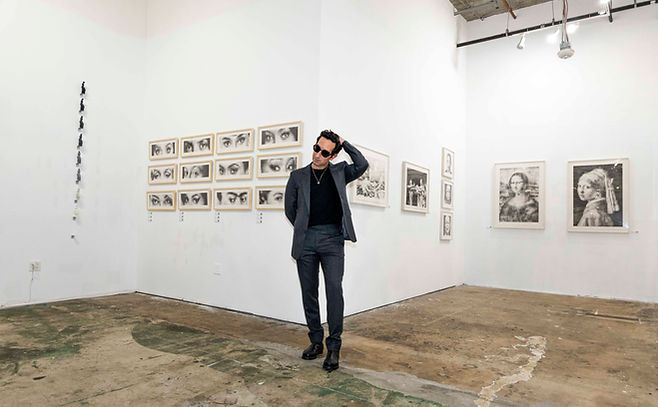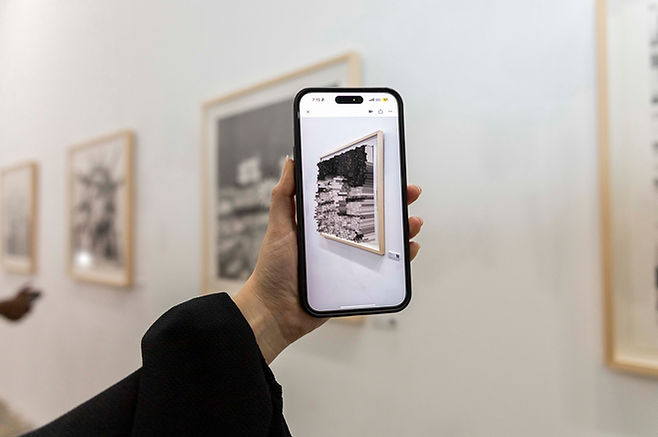ARTS & COLLECTIBLES
REDEFINING
ICONOGRAPHY
MAESTRO’s black-and-white drawings—meticulously rendered and intellectually provocative—offer collectors a rare convergence of architectural rigor, cultural critique, and hand-drawn mastery, with limited commissions currently available.
.jpg)
In an art world often enamored with spectacle, MAESTRO offers something quieter—and far more enduring. With the precision of an architect and the subversive eye of a cultural critic, this Spanish-born, Santa Barbara–based artist is producing some of the most thought-provoking and technically rigorous work in contemporary drawing today. Working exclusively in black ink on white paper, MAESTRO distills complexity into a language of silence, where images pulse with both immediacy and restraint.
Trained at the Polytechnic University of Valencia and the Stuart Weitzman School of Design at the University of Pennsylvania, MAESTRO’s formal background is in architecture—a discipline that continues to inform his meticulous process and spatial sensibility. Before fully devoting himself to art, he worked for esteemed firms including the Bjarke Ingels Group (B.I.G.), developing large-scale design concepts that now echo in his two-dimensional compositions. In every drawing, one sees the scaffolding of thought, the layering of perspective, the equilibrium between order and emotion.
His first solo exhibition, LOADING, which opened in April 2025 at HOMME Gallery in Washington, D.C., marked a seminal chapter in MAESTRO’s rising career. The series centers around pixelated icons—figures arrested in mid-transmission, their forms dissolving into digital uncertainty. These works are not simply glitch art or nods to nostalgia. They are philosophical inquiries. As MAESTRO explains, the “LOADING” series is rooted in a moment of personal frustration—images failing to render on his phone while newly arrived in the United States, a country he was still trying to understand. In that void, he found clarity.
.jpg)
.jpg)
Each image becomes a meditation on longing and loss, access and denial. Pop culture icons—those most globally visible—are rendered invisible, fragmented through the very medium that made them ubiquitous. The result is a kind of visual purgatory, where memory and recognition flicker like unstable signals. Viewers are left with the sensation of something just out of reach, a tension that lingers well beyond the gallery wall.
But what distinguishes MAESTRO, particularly in the eyes of serious collectors, is his refusal to conform to trends or convenience. His technique—hundreds of hours spent layering black ink with architectural control—is antithetical to the quick churn of digital art. There are no shortcuts here. Every millimeter is intentional. Every void is structural. This is work that demands time—both in the making and in the viewing.
His exhibition history is as focused as his art: from the Charles Addams Fine Arts Gallery and :iidrr Gallery in Manhattan to NeueHouse Hollywood, The Graffiti Library, and Sullivan Goss in Santa Barbara. With each showing, MAESTRO continues to build a body of work defined by intellectual depth, formal discipline, and an unyielding commitment to his craft.
Most of MAESTRO’s original drawings sell out upon release—a testament to the loyal and growing base of collectors who recognize his singular vision. And yet, for the time being, he remains open to a limited number of private commissions. For those seeking to acquire works of long-term significance—pieces that engage not just with aesthetics but with history, memory, and media itself—this represents a rare opportunity.
In an era of endless image production and digital noise, MAESTRO’s work dares to slow time down. It invites scrutiny, demands reflection, and rewards those willing to look beyond the obvious. His is a practice grounded in the architectural past, filtered through the fractured present, and headed squarely into the future. For the distinguished collector, it is not simply a matter of acquiring a drawing. It is the chance to own a fragment of cultural consciousness—rendered in silence, ink, and light.

Join our mailing list to receive curated updates, special features, and invitations to events that define the world of the discerning few.
Sign up today and never miss what’s next.






